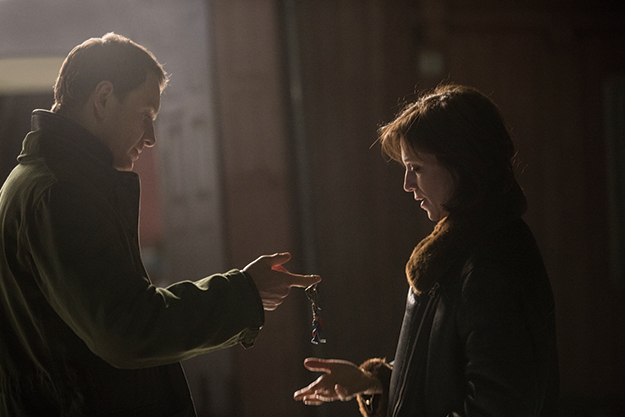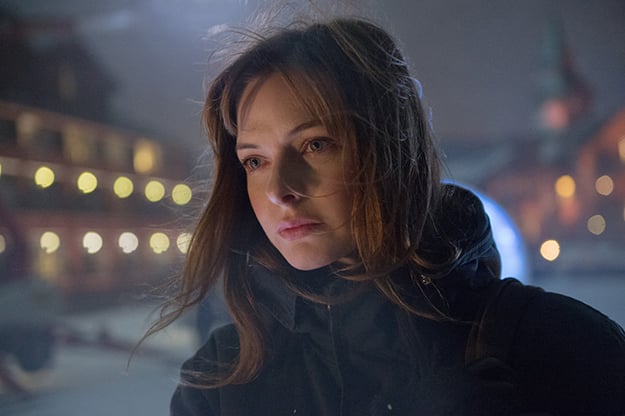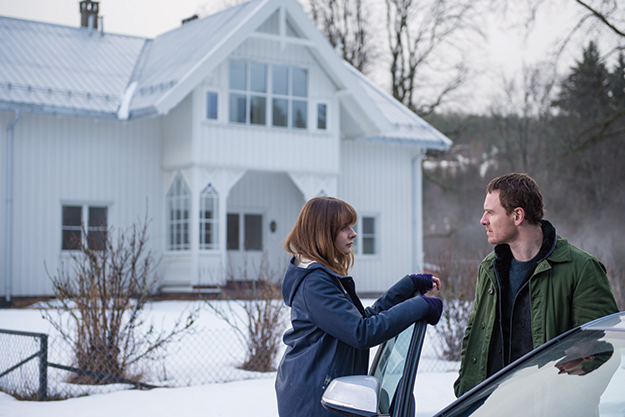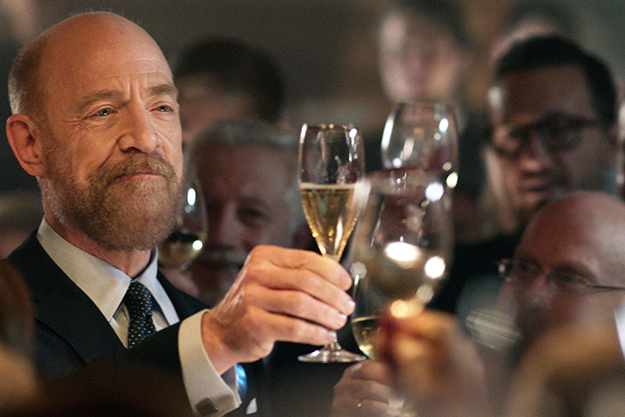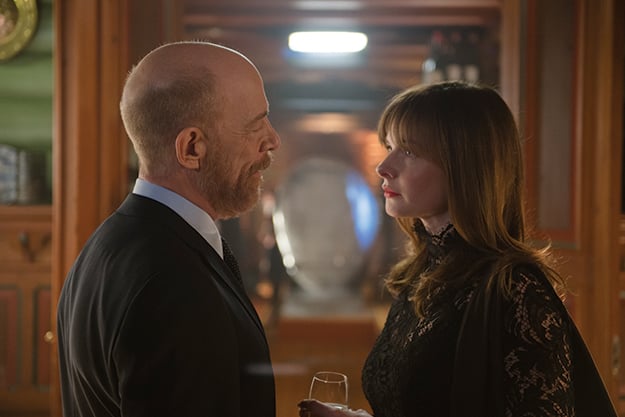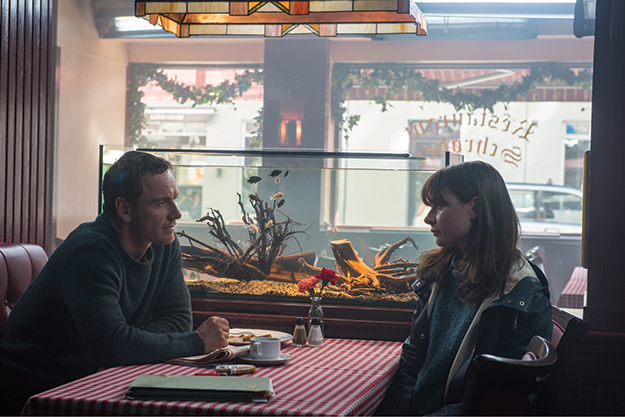Film of the Week: The Snowman
Going to the cinema is a bit like eating in certain restaurants that try to dazzle you with too much information: the more fancy ingredients that come listed after the name of a dish, the less you actually need to taste the thing. Similarly, the credits of some films come so ostentatiously laden with prestige that the safest thing might be just to gasp with appropriate respect, then walk on.
Tomas Alfredson’s The Snowman is based on a 2007 novel by Jo Nesbø, one of his gratifyingly tangled mystery thrillers featuring troubled cop Harry Hole. The cast includes Michael Fassbender, Rebecca Ferguson, Charlotte Gainsbourg, J.K. Simmons, Val Kilmer, Toby Jones, and Chloë Sevigny. The writers are Peter Straughan, Hossein Amini, and Søren Sveistrup, creator of the superb Danish TV series The Killing, which for many viewers worldwide established Nordic Noir as a recognizable thing back in 2007. The cinematographer is Dion Beebe. The executive producers include Martin Scorsese. One of the two listed editors is Thelma Schoonmaker. And Swedish director Alfredson made the striking vampire art-chiller Let the Right One In (08), followed by an unimpeachably fine adaptation of John le Carré’s Tinker Tailor Soldier Spy (11). Maria Djurkovic, responsible for that film’s superb production design, is here too.
I was almost tempted to put a reverential exclamation mark after every one of those names. How bad can such a film possibly be? The answer is: so bad that The Snowman may represent a limit case for the discrepancy between a film’s pedigree and what it delivers. As to why it’s so bad, Alfredson has given an interview explaining some of his troubles: the film went into production before it was properly ready, and the shooting time was too short, meaning that he lost certain scenes essential to the story. “It’s like when you’re making a big jigsaw puzzle,” he says, “and a few pieces are missing so you don’t see the whole picture.”
For those of us who like our movies elliptical, this sounds a very juicy prospect indeed. Alas, The Snowman is the sort of jigsaw in which the pieces are too few, too big and chunky, and the edges don’t properly fit together. But the film feels dead in a way that may not be entirely to do with production problems. Six years ago, David Fincher’s adaptation of Stieg Larsson’s The Girl With the Dragon Tattoo already felt like a retread of far too familiar material; its drama was based on that grimly perennial staple, spectacular violence against women, and only felt fresh because avenging heroine Lisbeth Salander was so much steelier and sharper than her male colleague. The Snowman, however, is just the routine old story of women, mainly, getting bloodied against some pretty scenery.
In Nesbø’s books, Oslo cop Harry Hole (Fassbender) is constantly brought to the edge of collapse by his harrowing work and crumbling personal life, but he always musters for one more case. Early in Alfredson’s film, he’s seen waking up in a bus shelter after a night outdoors. He’s the sort of movie drunk whose condition is signaled by a close-up of a hand that has clearly gripped the neck of a vodka bottle all night long and only now, bang on cue, lets it drop. The film doesn’t entirely convince us that Hole is in so grievous a state: he handles at least one cold night outdoors without looking too shop-soiled, and the image of Fassbender with his shirt off could be from the shoot of a Men’s Health feature on how to get the perfect torso the Absolut way.
The Snowman is clunky from the start. In the prologue, a teenage boy is traumatized when his suicidal mother crashes through thick ice into an icy lake. Fine—we’ll look out for that kid as the eventual killer. It works in a book, less so on film, where we’re specifically looking for an actor who could be that boy grown up. Alfredson’s casting doesn’t leave us that many choices.
You expect red herrings in Nordic cuisine, but The Snowman is as messy as the morning after the Oslo Seafood Gala. Chloe Sevigny plays a woman reported dead, who turns out to be alive; it then transpires that Sevigny is playing identical twins. When one of them is found dead, the other shakes her head—only one of the sisters actually has a head at this point—and mutters, “She was a free spirit.”
That’s all we get of Sevigny. The film squanders its cast with profligate abandon. Anne Reid, from Roger Michell’s The Mother, flits in as a witness and in a blink gives one of the best performances in the film. Toby Jones contributes a knowing glance or two. Charlotte Gainsbourg, as Hole’s ex, slinks about, silkily sotto voce. J.K. Simmons wears a big beard.
Strangest of all is a haggard Kilmer, resembling a caved-in papier-mâché effigy of David Johansen, his accent a vaguely Nordic approximation of John Huston; he looks as if he’s walked in out of The Greasy Strangler. Someone you’re really glad to see, though, is David Dencik, who was in Tinker Tailor and whose weaselly, grandstanding villain in Jane Campion’s recent Top of the Lake: China Girl arguably makes Dencik the new Klaus Kinski, or perhaps the new Dan Duryea. In The Snowman he enlivens every second he’s visible, as a gynecologist and part-time pimp in too-short trousers and toenail varnish.
However, much of the acting comes in an uninflected style that might have been conceived of as “Northern Minimalist,” but just feels narcotized. Fassbender and Ferguson, in particular, could almost have been acting in Norwegian, then hastily dubbed. Ferguson, so good in the last Mission: Impossible episode, is particularly ill-served. For a while, pursuing her own secret side investigation, her cop Katrine Bratt looks as if she’ll be this film’s intrepid, independent Lisbeth Salander—that is, once she’s done complimenting the more experienced Hole (“You’re up there with the legends”).
But by and by it turns out that Ferguson was here all along mainly to model black woolen thigh socks. Here’s a particular example of the film’s obtuseness. Bratt uses her charm to get a private appointment with Simmons’s wealthy man of power Arve Stop, known to be a terrible lecher. This is presumably why she’s dressed that way, to catch his attention. No doubt an old satyr would like nothing better than to find Bratt waiting for him in those socks; instead, the film abandons psychological plausibility and has Ferguson peel them off before the meeting, purely for the viewer’s benefit.
Equally silly is the film’s attitude to hardware. There’s a gizmo involved called EviSync, for recording testimonies; it plays its part, but requires characters to carry around something rather bulkier and harder to hide than an iPad. There’s also the fancy device that the killer uses for severing heads, which comes in a neat carrying case and which remains—considering the wear and tear it gets—improbably shiny. (Is this standard murder equipment you can buy online, or do you have to have it custom-made? At any rate, it looks expensive, so we’re looking for a suspect with a few krone stashed away. That should narrow the field.)
One of the most dismaying things about The Snowman is that the doomed mother at the start is played by Swedish actress Sofia Helin, so fine as autistic cop Saga Noren in TV series The Bridge. Along with The Killing, that show helped establish Scandi-noir as a distinctly classy brand, and casting Helin in this tiny role seems like The Snowman’s derisive lip service to something superior.
Nesbø’s novels are bulky and intricately plotted; why anyone thought that one of them could easily be squeezed into a two-hour box, heaven knows. Maybe that’s why The Snowman has three credited writers, and presumably too that explains editing credits for Thelma Schoonmaker as well as Claire Simpson: it suggests an emergency salvage mission that hasn’t come off.
The Snowman seems so feeble, at times risible a replication of things better done before that we could almost be watching a parody—Scandi Movie, perhaps. Alfredson established a distinctive Swedish flavor in Let the Right One In, establishing a drab urban milieu as a plausible site for vampire murders, while The Killing and The Bridge were so good because they evoked the everyday greyness of cities like Malmö and Copenhagen. The Snowman’s winter, however, is as folksy as a Dickensian Christmas. A character can’t just get on a train, we have to have a soaring aerial shot of that train speeding through a vast whiteness; you almost expect to see husky-drawn sledges racing by outside, bells a-jingle. That said, the best-looking sequence in the whole film is the snowbound title sequence, which shows the ominous Gustav Vigeland statues that are Oslo’s eeriest attraction.
This film may well be the last gasp of Scandi-noir for the international market: after U.S. remakes of The Killing and The Bridge, and the Swedish and Kenneth Branagh versions of Henning Mankell’s Wallander, this phase of Nordic has gone from original to dutiful emulation to dreary self-parody. It’s a shame that the last phase is from a Scandinavian director capable of so much more.
Still, I wouldn’t like to entirely let this crypto-genre go. We’ve seen Danish, Norwegian, and Swedish sleuths, each more screwed-up than the last. What I still hope to see is a Finnish cop thriller, ideally in the spirit of Aki Kaurismäki. The vodka-steeped cop hero spends the entire film in a ’50s-style Helsinki bar glumly staring at the jukebox as it plays tangos and rockabilly. Meanwhile, his dog goes out and solves the case.
Jonathan Romney is a contributing editor to Film Comment and writes its Film of the Week column. He is a member of the London Film Critics Circle.



